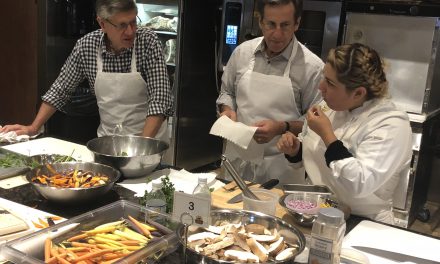This story is being written for the forgotten. For the downtrodden. For the castoff deemed unworthy to shine on center stage.
This is a story about survival. And consistency. And, ultimately, about reinventing oneself to emerge better, stronger and wiser than ever before.
This is the story, as you have probably guessed by now, of the sirloin steak.
If you think about it, we all have a little bit of sirloin steak in us. You know the feeling—that deep, droning yearn: that longing to be adored and appreciated for our most endearing qualities, yet always being overlooked by brighter, shinier, impossible-to-ignore alternatives.
The sirloin steak is human vulnerability personified on the plate. It’s the Jan Brady of beef cuts; it’s the bass player from Weezer on a sword. It’s something from which we can all identify. And for that, dear, meaty friend, we dedicate this story to you.



To appreciate the sirloin, one must first understand where it comes from.
Anatomically speaking, the sirloin resides within the same primal as the short loin—all together comprised as the ‘loin.’ The sirloin complex is divided into two parts: the top sirloin and the bottom sirloin. For purposes of where we are about to journey over the next 500 words or so, please note we are specifically discussing the top sirloin in its juxtaposition against the short loin.
The bottom sirloin, it should be noted, is well loved. To better demonstrate why the top sirloin’s apparent Middle Child Syndrome exists, know that its short loin sibling is made up of two steakhouse middle meat bastions: the strip and the tenderloin filet (Marcia! Marcia! Marcia!). And, if you leave them together and simply cut the entire complex into bone-in steaks, you make T-bones and porterhouses. The sirloin, meanwhile, also includes cuts that perform very well, although many folks have probably never heard of the coulotte steak or the baseball cut.
Diana Clark, resident meat scientist and unofficial ambassador of the national Make Sirloin Great Again movement, suggests the reason cuts from the top sirloin and short loin are viewed so differently can be traced back to how they have been cut for traditional consumption.
Mentions in meat cutting guides and food media publications of both the filet mignon and the strip steak (also called a “Delmonico” in the 1800s) date back well over 125 years. That means at least four generations of humans have grown up with these steak giants as part of their glorious, meaty existence.
The sirloin, mostly because of how it was fabricated, however, never really took off to such a degree. That’s because up until the last few decades, Clark says a “sirloin steak” referred to what’s now known as a massive face-cut sirloin, which contains several muscles running in opposite directions and offering different eating qualities, all contained in the same over-sized steak.
And, not surprisingly, when diners would feast on that old school Brontosaurus, it was underwhelming. Consequently, the sirloin has always been looked as the Frank Stallone to the short loin’s Rocky Balboa.


“But we can do better,” Clark says.
The top sirloin, also known as the ‘top sirloin butt’ or simply the ‘top butt’ (no, seriously) is comprised of three major muscles: the top sirloin cap, also known as the ‘coulotte’ or ‘picanha,’ the center-cut sirloin and the mouse.
The coulotte and the center-cut sirloin both eat incredibly well when separated and and cooked on their own accord. The mouse? Most of the time, it ends up as ground sirloin.


The coulotte
The coulotte has actually been used in South American cultures for eons as the go-to for skewered, churrasco-style cooking.
Is it tasty? You bet churrasco it is.
In the bevy of Brazilian steakhouses popping up all over, the coulotte is that strange, C-shaped cut shaved table side—most distinguishable through its thin exterior fat cap that curves along the beef.
But the beauty of the coulotte not only lies in the fact that it’s both tender and well marbled, but it’s also incredibly versatile. A coulotte can be dry roasted whole (they typically weigh around 3 pounds) with a fat cap that lends itself to an added layer of flavor. It can also be cut into individual steaks and grilled over high heat. You’ll notice that they even kinda look like N.Y. strip steaks.
If you’re a fan of the tri-tip, which can be hard to find (thanks, California), the coulotte is an amazing alternative.
Also, if you cook it whole, don’t be alarmed when it puffs up like a football in your oven or on your grill. Play it off like a cool party trick.
The center-cut sirloin
There is, perhaps, no greater injustice in the world than the damage done to the reputation of the center-cut sirloin.
Make no mistake: this is a delicious and versatile cut, both as a steak and a dry-roasted piece of meat.
But one can hardly read the word ‘sirloin’ without conjuring up images of their local, nondescript chain restaurant with waitstaff donning flair buttons and using phrases like “sizzler platter” far too often.
The sirloin’s reputation is that it’s your grandfather’s steak, or worse, a $9.99 bargain: a C-average, low-quality option that delivers a “meh” experience.
Reality couldn’t be more different, though. Remember that whole top sirloin complex? Well, when the coulotte is removed, the center-cut portion is what’s exposed. There is a large seam of connective tissue that dissects this, but by dividing the piece into two portions by cutting along that seam, both sides will be equally delicious.



If you said “filet,” you’re correct. But the word ‘filet’ merely describes the shape. None of the cuts are classic filet mignon, coming from the tenderloin.
From left to right, these are a filet of rib, filet of strip and, you guessed it, filet of sirloin—also known as a baseball-cut sirloin.
Like the rib and strip, the filet of sirloin eats remarkably well when cut against the grain.
Don’t believe it? Try it yourself.
This is the little secret folks who live in the meat world like to keep to themselves. Cuts from the sirloin are amazing pieces of meat that really don’t need any rubs or marinades to shine. And as an added bonus, usually cost a little less than their middle meat brethren.
Just make sure you use a sirloin from the upper echelons of the Choice and Prime grade, like the Certified Angus Beef ® brand, and think nice things about us when you’re feasting on the great, forgotten steak.





